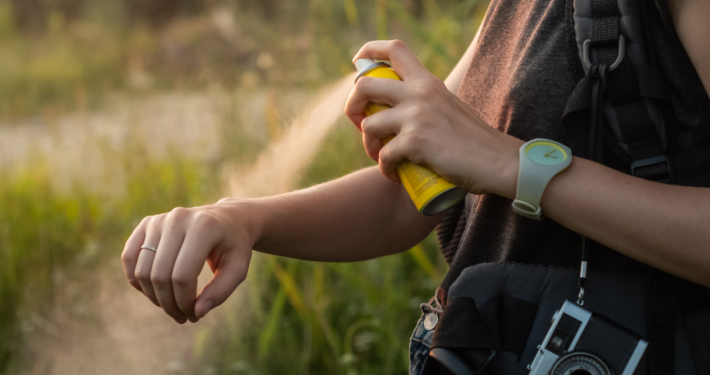Understanding Insect Repellent Active Ingredients: What Outdoor Workers and Safety Managers Need to Know
by: Richard Rich
When it comes to protecting outdoor workers from insect bites, selecting the right insect repellent is crucial. Insect bites can transmit serious diseases like Lyme disease, West Nile virus, and Zika, making repellents a key part of workplace safety. However, not all insect repellents are created equal. The active ingredient in a repellent determines its effectiveness, safety, smell, and how it feels on the skin. In this blog, we’ll explore the most common active ingredients in insect repellents—DEET, Picaridin, Oil of Lemon Eucalyptus (OLE), IR3535, and a brief look at natural repellents—focusing on the advantages of each and why IR3535 stands out as the top choice for outdoor workers.
DEET: The Long-Standing Chemical Pesticide with Significant Drawbacks
Overview
DEET (N,N-Diethyl-meta-toluamide) has been used since the 1940s and remains one of the most common active ingredients in insect repellents. It’s effective against a wide range of biting insects, including mosquitoes and ticks, and is often viewed as the gold standard of insect repellents.
Pros
- Effectiveness: DEET is proven to repel mosquitoes, ticks, and other biting insects, providing strong protection in heavily infested areas.
- Long-Lasting: Higher concentrations of DEET (20%-30%) can offer up to 8 hours of protection, making it reliable for long outdoor work shifts.
Cons
- Smell: DEET has a strong, distinctive chemical smell that many people find unpleasant.
- Skin Feel: DEET-based repellents often leave a greasy or sticky residue on the skin, making it uncomfortable for long-term use, especially in hot conditions.
- Material Damage: One of the most significant safety concerns with DEET is its ability to degrade plastics, rubber, and other materials. This poses a risk to workers wearing FR (flame-resistant) clothing, linemen rubber gloves, and other specialized gear. DEET can weaken the protective equipment, leading to potential safety hazards for outdoor workers.
- Neurotoxin Concerns: DEET is technically classified as a neurotoxin, meaning it can affect the nervous system. Though considered safe when used correctly, improper or excessive exposure to DEET has raised concerns about its long-term neurological effects.
- Eye Irritation: DEET can cause severe eye irritation if accidentally sprayed or transferred to the eyes from the skin.
- International Restrictions: Some countries have placed age restrictions on the use of DEET-based products, recognizing the potential risks it may pose to young children. For instance, in Canada, DEET products with concentrations above 30% are not recommended for children under 12 years of age.
Pesticide Classification
DEET is classified as a synthetic chemical pesticide, and while it’s highly effective, its potential safety risks and material degradation make it less ideal for long-term, repeated use in environments where specialized safety gear is necessary.
Picaridin: A Modern Synthetic Alternative with Key Considerations
Overview
Picaridin (also known as Icaridin) is a synthetic compound introduced in the 2000s as an alternative to DEET. It’s derived from a chemical found in black pepper and is gaining popularity due to its lower risk of skin irritation and its pleasant feel compared to DEET.
Pros
- Low Odor: Picaridin is almost odorless, making it a more pleasant option than DEET for outdoor workers who want to avoid strong chemical smells.
- Non-Greasy: It dries quickly and doesn’t leave a greasy residue, providing comfort for workers during extended periods of wear.
- Effectiveness: Like DEET, Picaridin is effective against mosquitoes, ticks, and other biting insects. It has been found to be just as effective as DEET, particularly at concentrations of 20%.
Cons
- Eye Irritation: Picaridin has been associated with causing severe eye irritation if it comes into contact with the eyes, which can be a risk in environments where workers are constantly moving and sweating. Careful application is necessary to avoid accidental contact with the eyes.
- Shorter Duration: In some environments, especially humid or high-sweat conditions, Picaridin may not last as long as DEET and might require more frequent reapplication.
- Synthetic Pesticide: While Picaridin is considered less irritating than DEET, it is still a synthetic pesticide. For workers or safety managers looking to reduce exposure to synthetic chemicals, this might be a concern.
Pesticide Classification
Picaridin is classified as a synthetic pesticide, and although it is less harmful to plastics and other materials compared to DEET, it still poses risks, particularly related to eye irritation.
Oil of Lemon Eucalyptus (OLE): The Natural Bio-Pesticide Option
Overview
Oil of Lemon Eucalyptus (OLE) is derived from the leaves of the eucalyptus tree, with its active ingredient being p-menthane-3,8-diol (PMD). This bio-pesticide has gained popularity as a plant-based repellent that is effective against mosquitoes and ticks.
Pros
- Natural Origin: OLE is a natural, plant-based repellent, making it appealing for those who want to avoid synthetic chemicals.
- Pleasant Scent: It has a lemony, eucalyptus-like smell, which many people find refreshing and far more pleasant than the chemical odor of DEET and Picaridin.
Cons
- Skin Sensitivity: Despite being natural, OLE can still cause skin irritation in some individuals, especially in high concentrations.
- Shorter Duration: OLE typically provides fewer hours of protection than DEET or Picaridin, requiring more frequent application.
- Age Restrictions: OLE is not recommended for use on children under 3 years old due to potential safety concerns.
Bio-Pesticide Classification
Unlike DEET and Picaridin, OLE is classified as a bio-pesticide, which means it is derived from natural sources. While it appeals to those seeking a natural solution, its shorter duration of effectiveness and potential for skin irritation limit its usefulness for long work shifts.
Natural Repellents: Citronella, Lavender, and Essential Oils
Overview
Natural repellents like citronella, lavender, peppermint, and other essential oils are often marketed as safer, plant-based alternatives to chemical repellents. While these natural ingredients are popular in personal care products, they have significant limitations when it comes to outdoor work environments.
Cons
- Limited Effectiveness: Studies have shown that essential oils like citronella and lavender offer very short-lived protection, often requiring reapplication every 30 minutes to 2 hours. This makes them impractical for outdoor workers who need reliable, long-lasting protection.
- Not EPA-Registered: Unlike DEET, Picaridin, OLE, and IR3535, these essential oils are not registered with the Environmental Protection Agency (EPA) as effective insect repellents. This lack of regulatory oversight means their effectiveness is not guaranteed, and they cannot be relied upon for professional use in hazardous environments.
- Skin Reactions: Some essential oils can cause allergic reactions or skin irritation, especially when used in high concentrations.
While these natural options may be appealing for casual use, they do not meet the rigorous safety and effectiveness standards required for protecting outdoor workers from disease-carrying insects.
IR3535: The Bio-Pesticide Champion
Overview
IR3535 (Ethyl Butylacetylaminopropionate) is a synthetic compound based on a naturally occurring amino acid found in the human body. Recognized by the Environmental Protection Agency (EPA) as a bio-pesticide, IR3535 provides effective protection with fewer risks, making it a superior choice for outdoor workers.
Pros
- Non-Toxic and Gentle on Skin: IR3535 is widely regarded for its safety profile. It is non-toxic and gentle on the skin, making it suitable for frequent reapplication without the risk of irritation or allergic reactions.
- Odorless: Unlike DEET and OLE, IR3535 is completely odorless, offering a more pleasant experience for outdoor workers who need to wear repellent all day.
- Non-Greasy: It dries quickly and does not leave a greasy residue, ensuring comfort during long shifts in physically demanding conditions.
- Effective: IR3535 provides broad protection against mosquitoes, ticks, and biting flies, with comparable duration to DEET, but without the drawbacks of material degradation or neurotoxicity.
- No Material Damage: Unlike DEET, IR3535 does not degrade plastics, rubber, or fabrics, making it safe to use with specialized safety gear like FR clothing and rubber gloves.
Cons
- Availability: While increasing in popularity, IR3535 may not be as readily available as DEET or Picaridin in all regions.
Bio-Pesticide Classification
IR3535 is classified as a bio-pesticide, meaning it is derived from natural compounds and is safer for both human use and the environment. For outdoor workers who need both long-lasting protection and comfort, IR3535 is the ideal choice.
Conclusion: Why IR3535 is the Clear Winner for Outdoor Workers
When it comes to protecting outdoor workers from insect bites, the choice of repellent matters. DEET and Picaridin, while effective, come with significant downsides like material degradation, eye irritation, and chemical exposure. Oil of Lemon Eucalyptus and essential oils may be appealing for those looking for natural solutions, but their shorter protection times and potential for irritation limit their practical use in the workplace.
IR3535 stands out as the best option for outdoor workers. It offers long-lasting protection without the smell, irritation, or material damage of other repellents. As a bio-pesticide, IR3535 provides a safer, non-toxic solution, making it the top choice for safety managers and outdoor workers alike.







